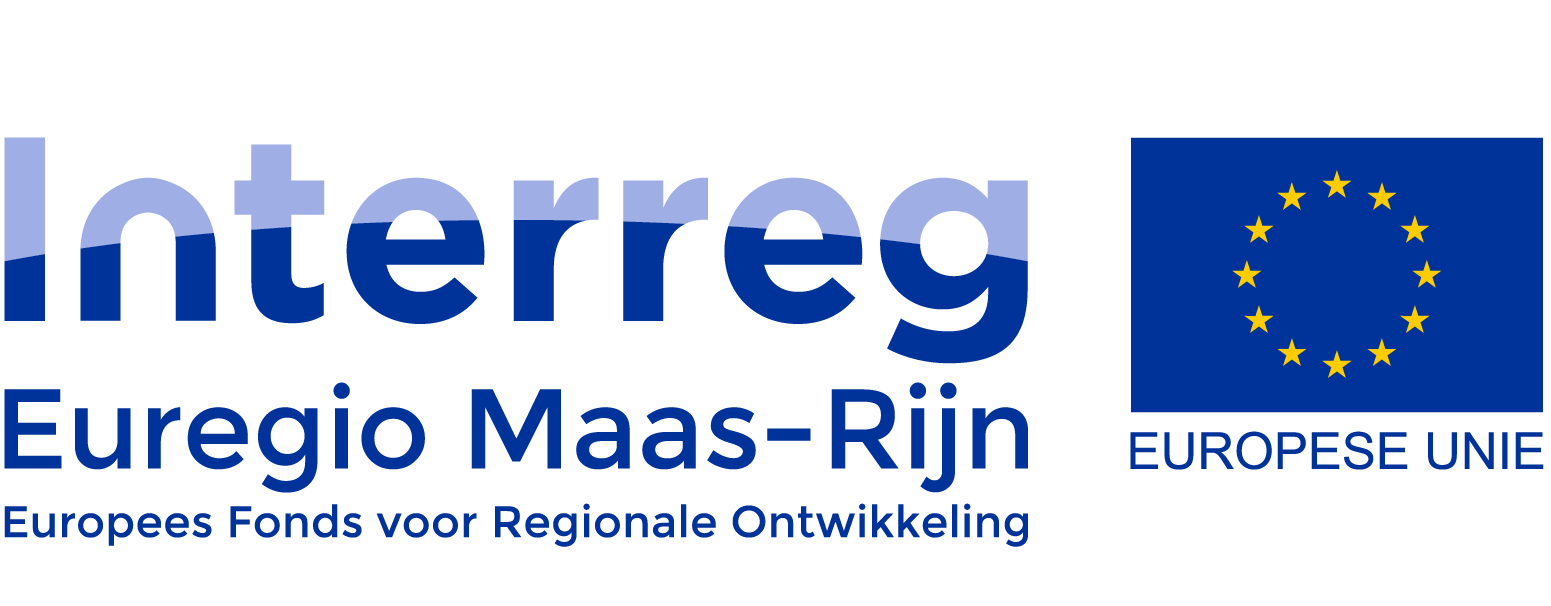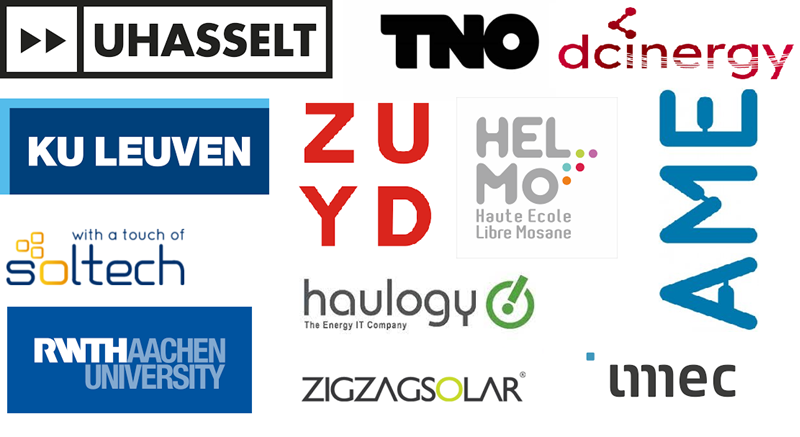SolarEMR
The SolarEMR project helps in getting integrated PV over the current roadblocks. In three main topics all partners work together and share their expertise. (i) designs and processes for automated production, (ii) optimal interconnection with various applications, and (iii) Economical opportunities for SME's.



This project is being carried out with a contribution from the European programme Interreg Euregio Maas-Rhine, which promotes innovation, renewable energy, a healthy environment and the labour market through cross-border projects.
European and nationally issued renewable energy targets are forcing local governments and commercial owners of public infrastructure to invest in durable energy solutions. More than that, it is being acknowledged that durability should become “business as usual” in realization of infrastructural and building projects. On 14 July 2021, the European Commission adopted a set of proposals to make the EU's climate, energy, transport and taxation policies fit for reducing net greenhouse gas emissions by at least 55% by 2030, compared to 1990 levels. Building and construction companies are used to realize infrastructural projects by subcontracting a great variety of specialized SME companies, which are bound to work according to tight regulations and quality systems. This means that the incorporation of durable energy systems in public infrastructure involves the development of new ways of working, and new regulations and quality systems for a large number of SME companies. The project aims to enable and increases both the efficiency and the public acceptance (esp. by SMEs) of renewable solar electricity generation in public road infrastructure and the built environment, and thus supports CO2 emission reduction and the circular economy. The work on grid topologies and energy management ensures efficient use of the generated energy while optimizing grid layout for applications such as fast electric vehicle charging, battery storage, and energy conversion (e.g. hydrogen). In principle, embedding current state of the art quality solar module materials in the currently available world-wide area of public road infrastructure and building elements would be sufficient to meet the global electric energy demand. Current state of the art is that multiple projects on solar-integrated road and building infrastructure have been realized producing tens to hundreds of MWhours/year; the technology is therefore just gaining momentum. By including both economic and EU legislation aspects and identifying opportunities and hurdles, we aim to increase public acceptance and speed up the long-term widely spread implementation by SMEs of integrated PV by SMEs, companies, and communities.
Objectives
-
The value chain of IPV: design process for automated and fast integration
Developing a design process over the entire value chain of integrated photovoltaics (IPV). This while keeping in mind automated production and integration steps or fast deployment in the field for infrastructure integration and specifics related to power electronics, grid connection, legislation and economic aspects. The design will also minimise material use and environmental impact. The main goal is to demonstrate the entire process in order to support future IPV ideas of other SMEs in the EMR region. -
Low voltage DC grid and coupling to DC applications
The project will demonstrate how to optimize the amount of electrical energy produced per IPV element under outdoor conditions (robust electrical interconnection lines, design and testing of power optimizers and inverters, cost effective electrical connection to point of use). This while taking into account a cross border applicable set of standards for electrical connection to the grid that complies with local legislation and certification. The project also wants to demonstrate advantages of a low voltage DC grid when coupling to applications such as fast chargers, battery storage or hydrogen storage of excess energy. -
Economics and legislation for IPV in the European context for SMEs
What legislation do SMEs have to observe in the European context? What economic and other benefits can they obtain? How can they share energy and maximize the return on their energy production? In short, which business models exist and what could possibly be done in the future? We will clarify all these matters in order to make this hurdle lighter in the future roll-out of integrated PV. This all fits in this densely built-up region with a dense road network, where we want to make optimal use of the further roll-out of PV, together with local producers and for local companies and communities.
Synergy
SolarEMR is a follow-up project on Rolling Solar (Interreg EMR) in which we developed and evaluated integration of large stretches (>1m) of silicon and thin film PV solar modules in infrastructural elements. SolarEMR extends to the Rolling Solar project by demonstrating automated mass production of bespoke silicon and thin film IPV and optimized electrical grid connection for local energy use. Additionally we support SMEs directly by investigating economic models and legislative aspects while identifying opportunities and hurdles. To achieve this, we make use of important synergies with the projects listed below:
- SolaRoad (TNO, Soltech): realization of a stretch of bicycle path near Krommenie, NL.
- Interreg V project ‘PV OpMaat’: integration of PV Solar functionality and electrical power conversion in building elements.
- EFRO/SALK project ‘SolSThore’ (KUL, imec, UH): Advanced solar technology for the integration into building roofs and façades and optimization of grid interaction by storage.
- Dutch TKI project ‘PV4Roads’: integration of PV Solar functionality in road elements based on crystalline solar cells.
- EU LIFE project “Solar Highways”, application of crystalline silicon based PV in noise barriers on Dutch highway A50 (TNO).
- EU project “CHIPs”: realization of cycle highways possibly including PV-integration.
- SONOB (Solar Noise Barriers), including a field test of noise barriers based on PV in combination with Luminescent Solar Concentrators (LSC’s) (TNO)
- Belgian ‘ETF’ project BREGILAB: Grid balancing by injection limits and local energy storage.
- Flemish project ‘BIDC’: Realizing safe and stable bipolar low-voltage DC power and data backbones
- EU project ‘HyPErFarm’: Hydrogen and Photovoltaic Electrification on Farms. Studying efficient usage and need for storage for electricity generated by Agri-PV.
- EU-H2020 IA STARGATE: significantly increasing the environmental sustainability of EU airports through developing and increasing actions to increase energy efficiency and decarbonize the airport ecosystem.
- EU-H2020 RIA PERCISTAND: development of innovative materials and processes for perovskite on chalcogenide tandem appliances.
- EU-H2020 RIA Phy2Climate: a global approach for recovery of arable land. As in this project, clear Flemish/Belgian/European legislation is missing, is complicated and covers multiple areas.
Project lead:
- Universiteit Hasselt
Partners:
- TNO
- imec
- ZUYD
- HeLMo - CRIG
- Soltech
- KU Leuven
- ZigZagSolar
- RWTH Aachen
- Haulogy.net
- DCINERGY
- AME
Cofinancers

Contact
prof. dr. ir. Michaël Daenen

Dr. Lieve De Doncker

Wetenschapspark 1, 3590 Diepenbeek, Belgium
